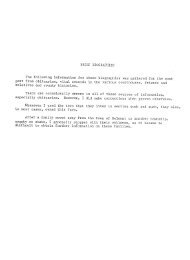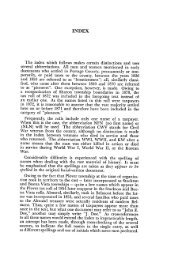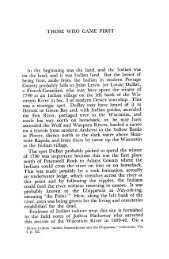ROSHOLT, THE VILLAGE OF Our Country Our Story ... - Library
ROSHOLT, THE VILLAGE OF Our Country Our Story ... - Library
ROSHOLT, THE VILLAGE OF Our Country Our Story ... - Library
You also want an ePaper? Increase the reach of your titles
YUMPU automatically turns print PDFs into web optimized ePapers that Google loves.
<strong>ROSHOLT</strong>, The Village of<br />
Seemingly hidden at the bottom of the page in the<br />
1858 tax roll of New Hope under a number of forties of<br />
land listed as "unkown" appears the single name "Steubli,"<br />
owner of 160 acres in Sec 20, Town 25. It is almost<br />
symbolical that this single freeholder, who is not even<br />
given a Christian name in the first tax roll, had come<br />
to live this far from any neighbor several miles to the<br />
south. He was Gottlieb Stanbly, or Steubli, or Stiple,<br />
or Stiply - the assessor never did get it straight - who<br />
was related to the Jacob Whipf family in Lola and probably<br />
through them had come to Wisconsin to make an<br />
entry on this quarter-section at the U. S. Land Office in<br />
Stevens Point on May 10, 1858.<br />
Stanbly built a log cabin on the high bank overlooking<br />
the South Branch of the Little Wolf near the north<br />
end of modern Main Street in Rosholt village.<br />
Apparently not a farmer by profession, Stanbly sold<br />
his land in 1861 to Theodor Stanbly, went off to war,<br />
rose to corporal in Company B, 14th Infantry Regiment,<br />
and died in service.' The land was purchased in 1867<br />
by Jens Rasmussen who moved into the log cabin built<br />
by Stanbly. Thus Rasmussen, a Dane from the island of<br />
Lolland, came to be the first permanent settler in the village.<br />
Professionally, he preferred tinkering with machinery<br />
to farming. Noting the need for a grist mill in<br />
the neighborhood, he installed stone grinding wheels<br />
powered by a winch that went with a sweep, pulled by<br />
oxen walking in a circle around the main shaft connected<br />
to the stone wheel apparatus. It was slow work and<br />
probably having noticed the beaver dam a few rods to<br />
the west of the cabin, Rasmussen decided to build a<br />
'Correspondence, National Archives and Records, washington, D. C.
<strong>ROSHOLT</strong>, <strong>THE</strong> <strong>VILLAGE</strong> <strong>OF</strong> 379<br />
grist mill run by water power. Peter Rasmussen, a nephew,<br />
said that it had been in operation for several years<br />
before he arrived from. Denmark in 1881.<br />
Meanwhile, John Gilbert Rosholt of Waupaca County,<br />
and Albert ("Muskego") Anderson, began operating<br />
a threshing machine and at least on one occasion,<br />
probably in the early 1 880s, brought their rig up as<br />
far as the Peer Dobbe farm, about a mile north of Alban<br />
Corners. Rosholt, a man in his late twenties, already<br />
owned a saw mill on Graham Lake in Waupaca County<br />
and probably through his venture in the threshing machine<br />
business in Alban came to note the great stand<br />
of white pine still standing in the northwest sections of<br />
the township. In 1881 he made his first purchase in the<br />
township by buying the timber rights on a forty owned<br />
by Hans J. Fredericksen in Sec 20. In 1884 he apparently<br />
made some arrangement with Rasmussen to<br />
share the water rights on the pond, tore down his saw<br />
mill on Graham Lake and moved the machinery to the<br />
new site on the South Branch of the Little Wrolf. In the<br />
next decade or so Rosholt bought up more timber<br />
forties both in the northwest of the township, as well<br />
as across thie town line in Marathon County. By 1902<br />
he had acquired enough timber to interest the big combine<br />
of Brooks 8c Ross Lumber Company of Schofield<br />
and Chicago.<br />
Many had speculated on the possibility of a railroad<br />
branch coming into Alban township, either from Eland<br />
Junction or from Norske. On Dec. 13, 1902 Rosholt<br />
signed a contract to sell the timber rights (except cedar)<br />
on his land to Brooks & Ross for $125,000. In return<br />
the lumber company was to arrange with the Chicago<br />
&e North Wrestern Railroad to run a branch down from<br />
Elderon to ship out the logs. The first train arrived in<br />
mid-October 1903. On Sept. 2, 1956 the last train left<br />
Rosholt and the tracks were torn up, another casualty<br />
of the automotive age.<br />
When it was definitely certain in the spring of 1903<br />
that the track layers were coming to Rosholt, the village<br />
became a boom town and no other in the county devel'-
380 OUR COUNTY OUR STORY<br />
oped quite as explosively. Business men with an eye to<br />
the future from lola, Amherst, and New Hope hurried<br />
to build hotels, hardware stores, grocery stores, warehouses,<br />
and residences. Several families lived in the<br />
back rooms or above their own stores the first years.<br />
Adolph Torgeson, a brother-in-law of J. G. Rosholt,<br />
operated the first store in the village in the mid-1880s.<br />
The store was in a log cabin located south of the pond.<br />
Around 1887 he built a frame building near the site of<br />
the present State Bank and continued in the business<br />
into the 1 890s. Another store was built at the south<br />
end of Main Street in the early 1890s by Jens P. Hanson<br />
Jr., and here, on March 2, 1893, a post office was established<br />
called Rosholt with Hanson serving as postmaster.<br />
The village, with a population of 382, was incorporated<br />
on Oct. 14, 1907 and, at an election held on Nov. 12,<br />
1902, the whole number of votes cast was 47, all for incorporation.<br />
The first election of village officers was<br />
held on April 7, 1908 when the following were named:<br />
J. G. Rosholt, president; George C. Nelson, Oscar G.<br />
Olson, Carl Knutson, Tom Warner, James Hanson and<br />
Carl Rosholt, trustees; 0. F. Meyer, clerk; Martin B.<br />
Wolding, treasurer; Ole Leklem, assessor; Charles Weller<br />
and Henry Goer, justices of the peace; John Himmes,<br />
police justice; George Philbrick, marshal; Peter Rasmussen,<br />
street commissioner, fire warden and pound-master;<br />
and John Gilbert, supervisor.<br />
From the first assessment roll, the following paid taxes<br />
in the village in 1908: Jacob Simonis, Henry Simonis,<br />
Johnny Simonis, Thor Jacobsen, Haral Haraldsen, Karl<br />
Knutson, J. G. Rosholt, Fred Simonis, Jens P. Hansen,<br />
Taylor Bros, Martin Peterson, Tom Torgrimson, Gunder<br />
Hansen, Andrewe Austin, P. N. Peterson, 0. F.<br />
Mayer, Charles Weller, Peter Gulliksen, Nels Tostenson,<br />
Alek Dahlinger, Stanislowsky 8c Guratski, J. Gilmister,<br />
Nick Kluk, P. M. Olfsen & Co., Alfred Olsen,<br />
Giszczinski 8c Dzwonkowsky, John Dzwonkowski, George<br />
Wolding, Wolding· Bros, John 0. Aas, C. J. Gilbert, T.<br />
J. Warner, A. T. Singstock, Carl Nottelsen, J. Golden,<br />
Jens Rasmussen, State Bank of Rosholt, 0. G. Olsen,<br />
Nottelsen Sc Sether, Rosholt Creamery Co., Alvin Sether,
<strong>ROSHOLT</strong>, <strong>THE</strong> <strong>VILLAGE</strong> <strong>OF</strong> 381<br />
Ole Wigen, Peter Rasmussen, John Rodomski, Joe Sabenas,<br />
Sr., Martha Lebee, Agnes Dahlinger, Albert S.<br />
Olsen, Martin Wolding, Tom Augistinak, A. Merde<br />
estate, J. L. Jensen, John Ezidor, Mike Gilmister, H. J.<br />
Fredriksen, Tom Windorf, J. C. Hansen, Chas. Winberg,<br />
Mike Cavanaugh, Rasmus Jensen (also known as "Black<br />
Rasmus"), Jacob J. Bakken, Emil Wrolstad, Isak Sather,<br />
Ole Leklem, Theodore Johnsen, Andrew Anderson, Halvor<br />
Bensen, Rasmus Jorgensen, Hans Lee, Torval Johnsen,<br />
George Philbrick, John Glodowski, Mike Domback,<br />
Jacob Dulac, Nick Simonis, Tom Mathisen, A. J. Torgerson,<br />
Joseph Whitcowski, J. 0. Wrolstad, John Kurozcinko,<br />
and John Zerwinski. Not mentioned in the<br />
real assessment, but together with some of the above in<br />
the personal property assessment of 1908 were N. A.:<br />
Anderson, Peter DeClark, W. J. Maxwell Lbr. Co., Herrington<br />
Sc Nelson, Lawrence Pettersen, Mrs. Clara Pettersen,<br />
lola Hardware Co., Glentski Sc Sabienas, Jr., Mrs.<br />
A. E. Baumford, Jim Fogerty, C. E. Slocum, John Himmis,<br />
Nels Tostensen, Theodore Krostu, Frank Manning,<br />
L. Starks, Farmers Produce Co., and Lewis Hansen.<br />
John Gas published a weekly newspaper, the Rosholt<br />
Echo, in the later part of 1905, and discontinued early<br />
in 1906. E. W. Look, a veteran of the Spanish-American<br />
War, edited the Rosholt Record probably from 1910 to<br />
1913. Otto F. Meyer, owner of the local drug store, apparently<br />
purchased Look's printing equipment and on<br />
March 13, 1913, published the first edition of the Rosholt<br />
Journal. 1 In 1915 he sold or leased the equipment to<br />
Harry T. Ravelin. Type was set by hand in "sticks"<br />
and printed on a hand-operated press resembling the<br />
first printing press of Albert G. Ellis. The paper was<br />
probably discontinued in 1918. On Oct. 22, 1920 Ross<br />
C. Woodhead, a World War I. veteran, began publishing<br />
a weekly called the Review which used a rotary press,<br />
and continued in business until Oct. 31, 1924. He was<br />
followed by H. Y. Buchanan who on Nov. 25, 1926 began<br />
publishing the Community Press, later taken over<br />
by William M. Schwartze who passed it on to Frank<br />
1 In collection of Pioneer Museum, Rosholt, Wris.
382 OUR COUNTY OUR STORY<br />
Freimund. The latter discontinued in the early 1930s.<br />
The first building of the State Bank of Rosholt, a<br />
frame structure, was built on the northwest corner of<br />
Main Sc Randolph Streets in the fall and winter of 1903-<br />
04, and the bank opened for business Feb. 6, 1904 with<br />
a capitalization of $10,000. From the 1908 tax roll it<br />
is learned that J. G. Rosholt owned 70 shares, and sons<br />
Carl, Milton and Jens each had ten shares. In 1921 a<br />
modern brick structure was completed. The capitalization<br />
was increased in 1913 to $f25,000, in 1921 to $40,000,<br />
in 1946 to $55,000, and in 1955 to $80,000. At the close<br />
of the business year of 1957 the bank had total deposits<br />
of $2,850,192.10 and a capital structure of $253,666.26.<br />
Directors in 1958 were Mrs. Carl Rosholt; Mrs. Tilda<br />
Rosholt, widow of Norman Rosholt; Lester Peterson, a<br />
grandson of J. G. Rosholt through his mother, Cally<br />
Juliana, only child of a first marriage; Vernon Rosholt,<br />
a grandson through Carl by a second marriage; and Malcolm<br />
Rosholt, a grandson through Milton by a second<br />
marriage. Carl Rosholt, who began as cashier in the<br />
bank the day it opened in 1904, continued uninterruptedly<br />
until 1937, and as president down to the beginning<br />
of 1958 when, owing to illness, he was replaced by Lester<br />
Peterson.<br />
The State Bank of Rosholt made state-wide headlines<br />
the day following an attempted hold-up on Sept. 4,<br />
1924 which was foiled by the daring of Carl Rosholt who,<br />
true to the frontier spirit in which he was nurtured,<br />
grabbed the pistol under the counter and exchanged several<br />
rounds of fire with the hold-up men. Under this<br />
barrage the two men who entered the bank, and a third<br />
man posting outside, retreated to a waiting automobile<br />
and were driven away by a captive chauffeur. A posse of<br />
local citizens under the village constable, Ingwald Hanson,<br />
was formed to follow the get-away car. Later in the<br />
day the men were trapped on a road near Bevent and<br />
when ordered to surrender, jumped out of their car and<br />
dashed into a nearby woods. One was shot and killed on<br />
the spot and the two others were captured a few days<br />
later, all by local men who also knew a thing or two about
<strong>ROSHOLT</strong>, <strong>THE</strong> <strong>VILLAGE</strong> <strong>OF</strong> 8<br />
guns. The captive chauffeur had given himself up on<br />
the Bevent road and was later exonorated.<br />
In the summer of 1917, probably, a Guernsey Breeders'<br />
picnic was held under the white pines on the hill north<br />
of the village, (later donated to the village as Hill Park'<br />
by J. G. Rosholt), and out of this picnic developed a community<br />
fair, organizd in 1926 as the Free Community<br />
Fair Association, which has become a three-day event held<br />
each Labor Day weekend and annually attracts around<br />
20,000 visitors. W1hen the Great District Fair was suspended<br />
in Stevens Point in 1927, the Free Community<br />
Fair, on a petition to the County Board in 1929,' was<br />
designated the official county fair for Portage County.<br />
State aids were extended for agricultural, livestock, floral<br />
and crafts exhibits in 1928. In 1948 on the occasion of<br />
the Wisconsin state centennial, the County Board appropriated<br />
$500 to move a log cabin to Hill Park, since<br />
known as the Pioneer Museum, where several hundred<br />
exhibits and photographs of central Wisconsin pioneer<br />
life and culture have been assembled by Malcolm Rosholt,<br />
director of the museum. In 1955 a second log structure,<br />
once used as a granary in the town of New Hope,<br />
was purchased by the State Bank of Rosholt as a public<br />
service and moved to the museum site.<br />
In 1948 a group of local businessmen, in an attempt<br />
to provide employment for seasonal labor and others,<br />
organized the Rosholt Box Factory. It began with the<br />
manufacture of cheese boxes, but shortly switched to<br />
the manufacture of wooden pallets used as platforms<br />
for fork lift trucks. The plant employs about 15 men<br />
the year around. The business has prospered and the<br />
stockholders have already realized their original investment.<br />
In 1954 Arthur Doede, one of the stockholders,<br />
withdrew from the firm and organized Doede Manufacturing<br />
Company which also makes pallets and employs<br />
about an equal number of men. Both of these small<br />
factories are excellent examples of home industry and<br />
the fruit of private initiative.<br />
In 1958 a new village hall, beautifully faced with light<br />
brick, was completed on Main Street and which replaced<br />
the earlier frame structure located on the right
384 OUR COUNTY OUR STORY<br />
bank of the river on Randolph Street.<br />
Serving the village of Rosholt, with a population of<br />
511, in 1957-58, were Fred Dahlen, president; John Wanserski,<br />
Felix Kranski, Gerald Dobbe, Wrilliam Czerwonka,<br />
Ralph Colrud, and Ben M. Johnson, trustees; Allan<br />
Gilbert, clerk; E. A. Depka, treasurer; Harry G. Hanson,<br />
assessor; Walter Oestreich, justice of the peace; P. Oliver<br />
Olson, constable; Dr. V. A. Benn, health officer;<br />
and A. P. Dobbe, supervisor.
.<br />
.<br />
.<br />
<strong>Our</strong> <strong>Country</strong> <strong>Our</strong> <strong>Story</strong> Portage County Wisconsin - Link Page<br />
PREVIOUS...PLOVER, <strong>THE</strong> UNINCORPORATED <strong>VILLAGE</strong> <strong>OF</strong>.......................................................370<br />
NEXT.......SHARON, <strong>THE</strong> TOWNSHIP <strong>OF</strong>.....................................................................385<br />
GO BACK TO <strong>THE</strong> ELECTRONIC INDEX PAGE...<br />
<strong>Our</strong> <strong>Country</strong> <strong>Our</strong> <strong>Story</strong> Portage County Wisconsin - Link Page
















